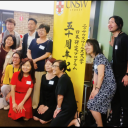 Japanese Culture Snippets
Japanese Culture Snippets
What is wagashi ?
Written by Shunichi Ikeda
(Visiting Fellow, College of Asia and the Pacific, The Australian National University)
Co-writer: Miona Ikeda

Traditional confectionery to celebrate Japanese culture
The word “wagashi ” translates to “Japanese sweets” or “Japanese snacks”. Wagashi are made in a wide variety of shapes and consistencies, using a diverse range of ingredients and preparation methods. Many can be found across the country, all year round, while others are only available seasonally or in certain regions of Japan.
While modern influences have created many new types of wagashi, traditional wagashi are mostly plant-based, containing no dairy, as well as using agar instead of gelatine for texture. Because of the predominant use of natural ingredients, wagashi are considered to be healthier than typical Western sweets or snacks, which are often high in sugar content and processed ingredients.
Wagashi often feature beautiful and intricate designs reflecting Japanese culture, making them works of art along with being delicious treats. They have continued to hold significance at Japanese festivals, tea ceremonies, and life events, as well as being a part of everyday life for Japanese people.
Categories of wagashi
There are many different types of wagashi, but an easy way to differentiate between them is through the methods used to make them. The Tokyo Wagashi Association breaks down wagashi into seven categories:
1. Mochimono : made with mochi (sticky rice)
2. Mushimono : made by steaming
3. Yakimono : made by baking
4. Nagashimono : made using a mould
5. Nerimono : made by shaping bean paste
6. Okamono : made by combining separate ingredients
7. Uchimono : made using a mould and hardened through beating
Another way to categorise wagashi is by moisture content, which further splits wagashi into three groups: namagashi with a moisture content of 30% or higher, han-namagashi with a moisture content between 10-30%, and higashi with a moisture content below 10%. As you can see, the many different categories of wagashi show just how broad the term is and how many different types exist.
Representation of seasons and regions
Seasonal wagashi are popular with both locals and tourists. Specific motifs and themes are used in the designs of seasonal wagashi and are typically showcased as sakura (cherry blossoms) for spring, water for summer, leaves for autumn, and snow for winter.
There are also certain flavours used in seasonal wagashi —for example, autumn wagash i often feature earthy, warm flavours such as chestnut and persimmon. There are also certain flavours used in regional wagashi —for example, many types of wagashi from Kyoto use their speciality “Uji matcha ” as a key ingredient, which is considered as the highest quality Japanese green tea powder.











